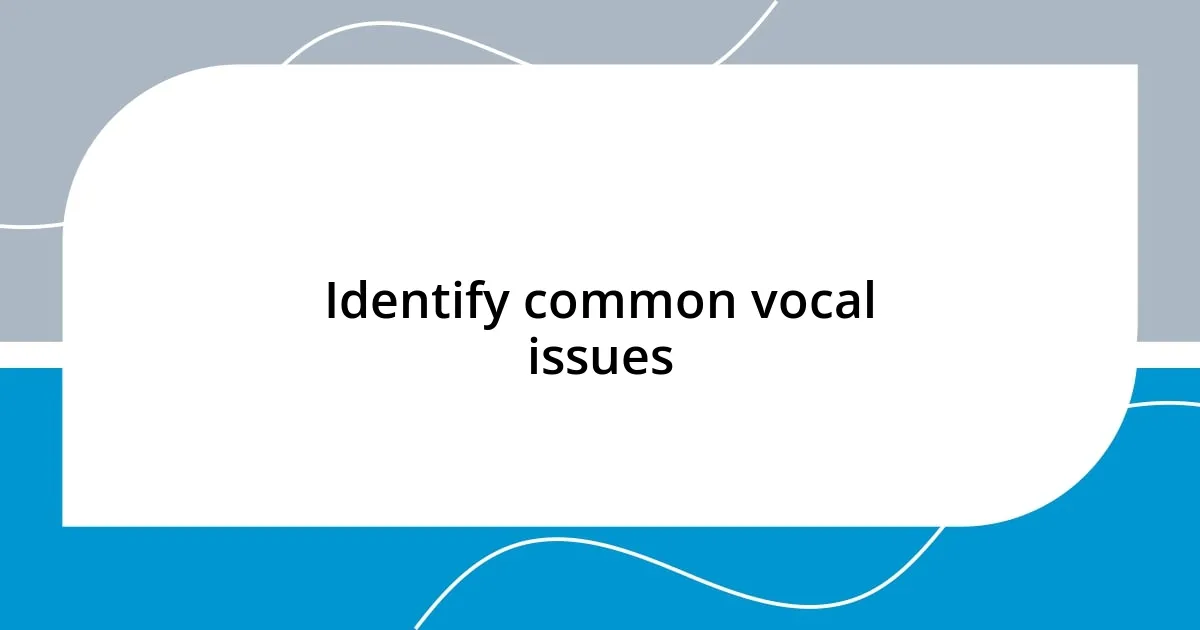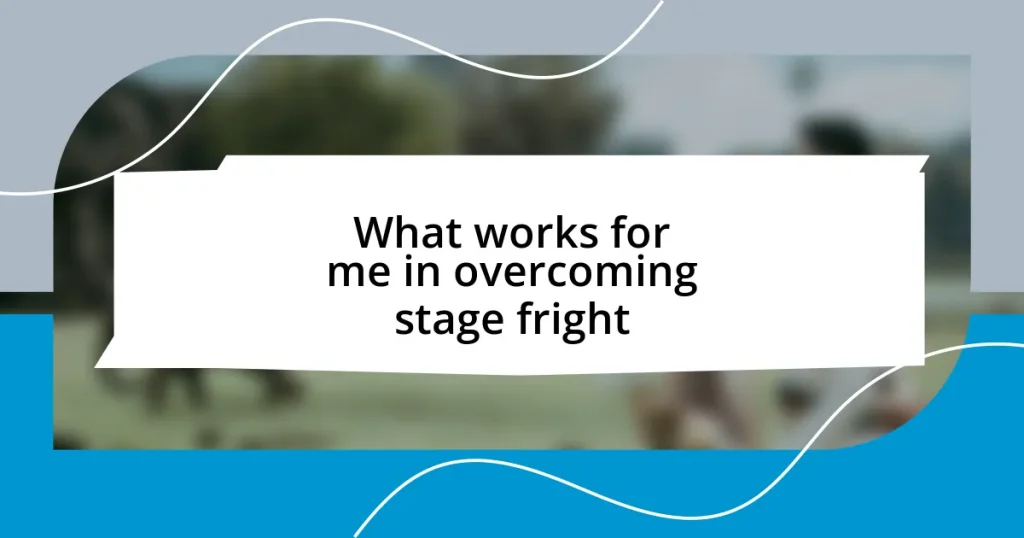Key takeaways:
- Vocal clarity enhances communication, builds credibility, and fosters deeper connections with audiences.
- Common vocal issues include mumbling, breathiness, and monotone delivery, which can hinder effective communication.
- Breathing techniques, warm-up exercises, and proper diction are essential for improving vocal clarity.
- Monitoring progress through recordings helps identify areas for improvement and encourages personal growth in vocal skills.

Understand vocal clarity benefits
Vocal clarity transforms communication. I remember the first time I delivered a speech with clear articulation; the audience nodded and engaged more than ever. It was empowering to see how my words connected with them—something I hadn’t fully grasped before.
When you speak clearly, it not only enhances understanding but also builds credibility. Think about times you struggled to follow someone else’s message; it can be frustrating, right? I’ve found that when I prioritize clarity, people listen more intently, which helps to foster a deeper connection.
Moreover, the emotional impact of vocal clarity should not be underestimated. I once joined a workshop focused on this very topic, and I was amazed at how much my confidence skyrocketed. It feels incredible to convey my thoughts without being misunderstood—who doesn’t want that sense of assurance in their voice?

Identify common vocal issues
One common vocal issue that many people face is mumbling. I remember attending a presentation where the speaker was passionate, but I struggled to catch their words. It was frustrating, and I found myself focusing more on deciphering their message than engaging with the content. This illustrates how mumbling can break the flow of communication and lead to misunderstandings.
Another frequent challenge is breathiness in the voice. There have been moments in my speaking journey where nerves got the better of me, leaving my sentences sounding thin and shaky. Breathiness can diminish the authority of your message, causing listeners to perceive you as less confident. Recognizing this issue has led me to focus on breathing exercises, which significantly improved my vocal projection.
Finally, monotone delivery often hampers effective communication. When I used to deliver my thoughts without varied pitch or emphasis, I noticed my audience’s attention drifting. It’s a vivid reminder that using vocal variety can greatly enhance engagement. By learning to infuse emotion into my speech, I’ve seen remarkable changes in how audiences react.
| Vocal Issue | Description |
|---|---|
| Mumbling | Involves unclear pronunciation, often leading to misunderstandings. |
| Breathiness | A thin, shaky quality that can undermine authority and confidence. |
| Monotone Delivery | Lacks variation in pitch, resulting in diminished audience engagement. |

Develop breathing techniques for clarity
Breathing techniques play a crucial role in achieving vocal clarity. I’ve come to realize that the way I breathe can directly influence my voice’s strength and resonance. For instance, I often practice diaphragmatic breathing, which involves expanding my belly rather than my chest when I inhale. This method not only provides more air but also gives my voice that rich depth, making it clearer and more robust.
To develop effective breathing techniques for clarity, consider the following exercises:
- Diaphragmatic Breathing: Lie on your back and place a book on your stomach. Focus on raising the book as you inhale deeply. This can help you engage your diaphragm.
- Controlled Exhalation: Practice speaking while slowly exhaling. Start with a single word or phrase and gradually increase the length to improve your breath control.
- Sustained Vowel Sounds: Choose a vowel sound and sustain it for as long as possible. This will aid in developing breath support and vocal endurance.
Implementing these exercises has genuinely transformed how I communicate. My voice feels stronger and more confident, making it much easier to connect with audiences.

Practice vocal warm-up exercises
Practice vocal warm-up exercises
Engaging in vocal warm-up exercises is essential for any speaker looking to enhance their vocal clarity. I remember the first time I neglected my warm-ups before a big presentation. My voice felt tight and strained, making it difficult to deliver my message confidently. Can you imagine the difference a few minutes of warm-up could make? Just a little effort can transform your voice from a cautious whisper to a powerful tool of expression.
One effective exercise I swear by is humming. It’s a simple yet powerful way to relax the vocal cords while also warming them up. I usually find a comfortable pitch and hum softly, gradually increasing the volume. It’s surprisingly soothing! I often think of it as giving my voice a gentle massage, preparing it for the task ahead.
Another favorite of mine is the lip trill. By blowing air through my closed lips to create a sound, I can feel the vibrations throughout my face. It’s such a silly thing to do, but it feels fantastic and loosens up my entire vocal mechanism. Have you ever tried it? If not, I highly recommend you give it a shot—it’s fun and productive all at once!

Utilize proper diction and articulation
Utilizing proper diction and articulation is fundamental to conveying your message clearly. I often find that the choice of words and how distinctly I pronounce them can be the difference between leaving my audience inspired versus confused. For example, when I prepare a speech, I make a conscious effort to articulate each word, particularly the consonants. This practice helps ensure that every point I make resonates with clarity, allowing forward energy in my delivery.
When I’m working on articulation, I sometimes turn to tongue twisters as a fun challenge. They may seem like silly games, but I’ve noticed a significant improvement in how my words flow during conversations. For instance, practicing phrases like “She sells sea shells by the sea shore” gives my tongue a workout, sharpening my ability to enunciate. It’s remarkable how a lighthearted approach can enhance an essential skill like vocal clarity.
Moreover, I often record myself reading aloud. There’s something revealing about hearing my own voice playback; it helps me identify areas where I might be mumbling or losing precision. In those moments, it’s almost like having a conversation with my past self—reminding me to slow down and truly focus on how I communicate. Have you tried recording your voice? You might be surprised by what you discover!

Implement daily vocal exercises
Implement daily vocal exercises
Implementing daily vocal exercises has been a game changer for me. I noticed how much more control I had over my voice when I started incorporating just ten minutes of focused practice into my morning routine. Who would have thought that such a small time investment could yield such big results in clarity and confidence?
One of my go-to exercises involves singing scales. At first, it felt a bit awkward, but now, I see it as a joyful ritual. I find a comfortable scale, and as I sing each note, I can feel my vocal cords vibrating with strength. It’s invigorating! The process opens up my throat and prepares me for the speaking engagements ahead, almost like a morning coffee for my voice.
Additionally, I try to add resonance exercises like using “ng” sounds. You know, the sound you make when you say “sing”? This exercise might sound funny when done in public, but I really enjoy how it vibrates through my skull—it’s oddly satisfying! Each time I practice, I remind myself that every little effort contributes to my larger goal. Have you thought about what daily exercises you could incorporate into your routine? The possibilities are endless, and the benefits are profoundly rewarding!

Monitor progress with recordings
Monitoring progress with recordings is one of the most illuminating tools I’ve discovered. Recently, I set aside time each week to playback recordings from my speaking practice, and it’s like unveiling a new layer of understanding about my vocal habits. I’m often surprised by the nuances I pick up, like subtle changes in pitch or the tendency to rush through certain sections. Have you ever listened to a recording and thought, “Is that really how I sound?” It’s an eye-opening (or should I say ear-opening) experience!
As I review my recordings, I find it’s not just about what I hear, but also how I feel when I listen. At times, I’ve cringed at parts where my words felt unclear, but this honest feedback fuels my motivation. I remember one particular recording where I noticed my speech sounded monotone, making me feel a bit deflated. Instead of letting that discourage me, I turned it into a challenge, working on adding more inflection and energy the following week. There’s something incredibly empowering about recognizing growth from honest self-reflection.
I suggest keeping a vocal journal alongside your recordings. Make notes on your progress, the challenges you face, and the improvements you hear. Reflecting on these details brings deeper awareness, reinforcing your commitment to clarity. This practice has transformed my journey—it’s amazing how tracking my progress helps me set specific goals and celebrate the small victories along the way. Have you considered how documenting your vocal journey could enhance your clarity? I believe you’ll find the insights incredibly rewarding!














